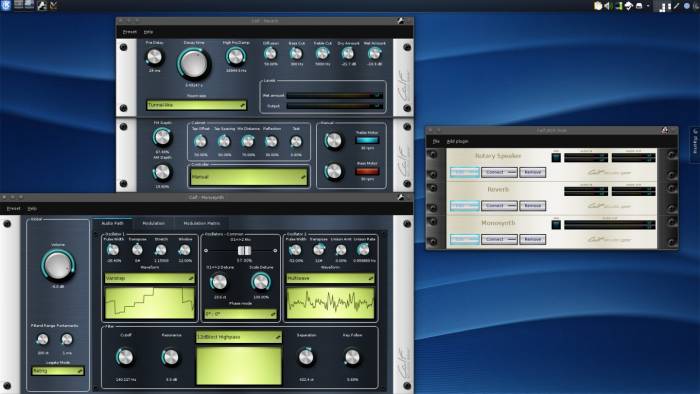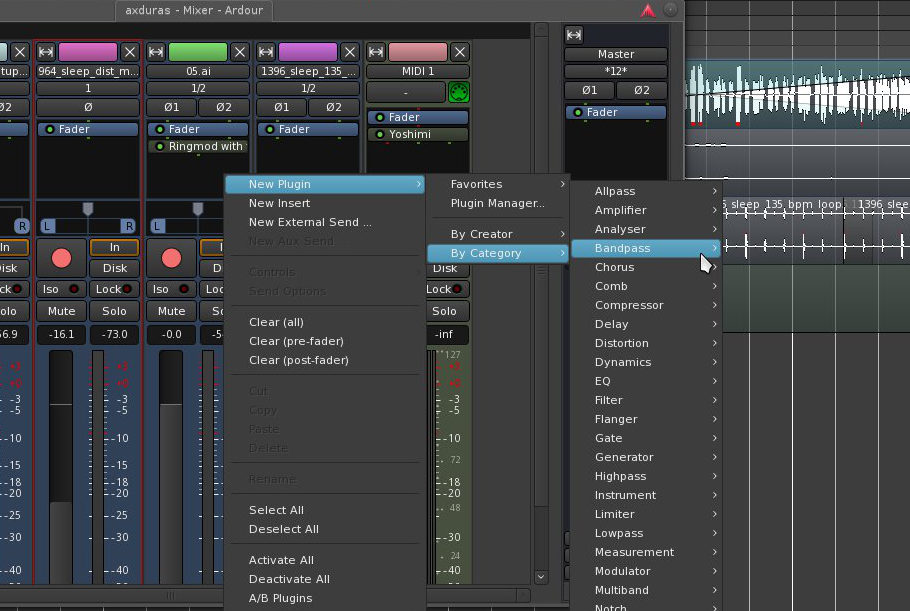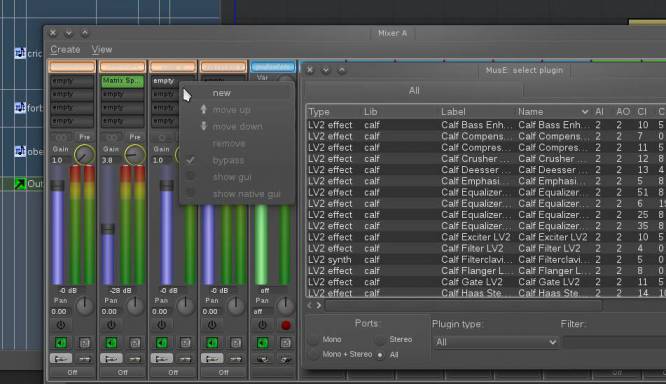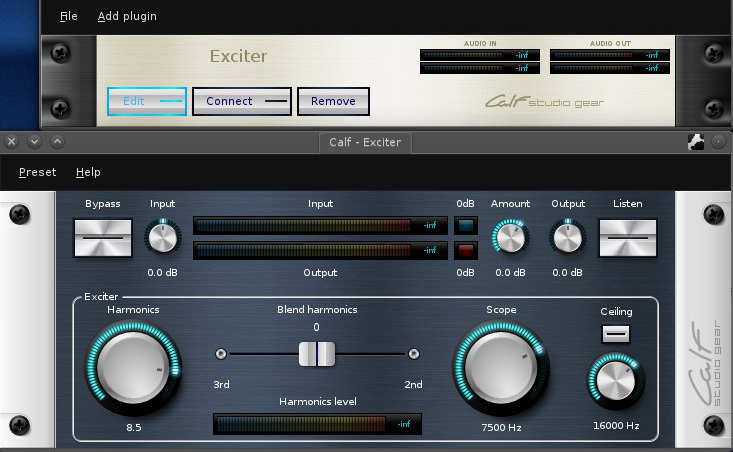Calf Studio Gear
Whether you want to drown your vocals in reverb or just need to put a gate on your Master Out, the Calf collection of sonic toys and tools probably has what you need. Plug some sound into this, and prepare to be amazed.
Strengths [Weaknesses]
Stable
Audio effects are not easy to generate, but the Calf audio effects are some of the most stable and reliable available.
Attractive
If you want your audio rig to look good as well as sound good, the new UI for Calf effects are nothing like the old utilitarian sliders and number fields from the days of old. These are attractive and enviable GUI applications.
Complete
The Calf collection is nearly an entire studio, encompassing synths, a sample player, effects, and utilities like gates and compressors and limiters.
Fun
You make music because it's fun. Calf effects play along.
Weaknesses [Strengths]
New
Calf effects recently got a major overhaul, and with that, the new Calf plugins may not work with your old projects that used Calf. Of course, Calf is open source and open source never really dies, so you can install the original Calf plugins to go back through your old projects and freeze the tracks using the effects. However, you cannot have both the original and the new plugins installed.
Install
Installation of Calf studio gear is theoretically straight-forward, but for the transitionary quirks resulting from the recent update from the LADSPA format (the Linux native plugin format, akin to VST, RTAS, or AU) to LADSPA version 2 (lv2 for short).
If you have old music projects that used the original Calf plugins, then now would be a good time to install Calf version 1 and freeze or bounce your tracks, baking in the effects to relieve the projects from depending upon old Calf plugins.
You can get the old Calf plugins from http://slackbuilds.org/repository/14.1/audio/calf, or from this anonymous backup location (the md5sums have been verified, and this backup is a trusted source).
To install the new Calf plugins, use the Slackermedia builds. Installing Calf provides access to both Calf as a plugin, as well as Calf as a standalone effect rack.
Plugin
Calf effects are LADSPA (v1 or v2, depending on which version of Calf you have installed) effects, LADSPA being a native audio plugin format for Linux, much as VST, RTAS, or AU are plugins for closed source systems. Simply put, that means they can be loaded as part of a DAW as long as your DAW supports LADSPA plugins (and even into a non-DAW such as Audacity).
Any given DAW might implement the process of loading plugins differently, but it's usually something you either associate with the track (since a track is basically a mixer channel) or it's something you do as an action within the virtual mixer.
For example, if you wanted to add a Calf effect in Ardour, you could:
- Click the track you want to put the plugin on (or, more accurately, that you want to pipe through the plugin).
- Open the Mixer window from the Window menu, or switch to it if it is already open.
- Right-click in the black Fader panel at the top of the channel strip and select New Plugin from the contextual menu.
- Choose the plugin you want to insert.
It's a similar process for Muse (LV2 support is in 2.2 and above only):
- Click the track you want to put the plugin on (or, more accurately, that you want to pipe through the plugin).
- Open the Mixer A window from the View menu, or switch to it if it is already open.
- Right-click in one of Effect Rack slots at the top of the channel strip and select New from the contextual menu.
- Choose the plugin you want to insert.
The plugins are racked inside of the DAW, and its connections are managed by the DAW, so there is no particular need to save your settings or record JACK connections; that's why you are using a DAW, after all.
Stand-Alone (Calf Jack Host)
The Calf plugins ship with a host, making Calf filters double as stand-alone effect units. You might want to use Calf in this way if your workflow is very modular, or if you prefer to track your effects manually rather than committing them to an all-in-one DAW.
To use Calf as a stand-alone rack, launch Calf from the K-Menu or calfjackhost & from a terminal.
Calf v1 effects can be loaded into Jack Rack, Calf LV2 effects cannot, so to use Calf LV2 plugins, you must use Calf Jack Host or an LV2 rack (like Jalv or Lv2Rack).
The initial interface is underwhelming.
This, of course, is just the empty rackspace; populate this rack with the Add Plugin menu. Each plugin that you add appears in the rack. The rack itself is one window, but each one creates a new entry in your JACK patchbay, so individual instruments can be sent through each plugin separately.
Edit the settings of each effect unit with the Edit button.
Sessions
Using Calf as a stand-alone effect means that no DAW is managing the effect settings for you. Whatever you do, from which plugins are in your rack to any custom settings, will be lost if you do not save them.
To save settings in your rack, use the File menu > Save. Slackermedia recommends consolidated project management (see Planter for more information), saving your setting file along with any other assets associated with the project you are working on.
See Also
Jack Rack
Audio Filters
Synths




